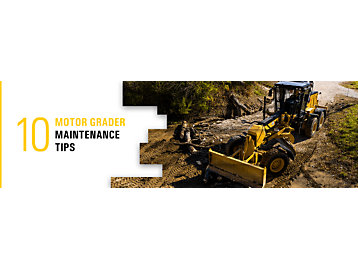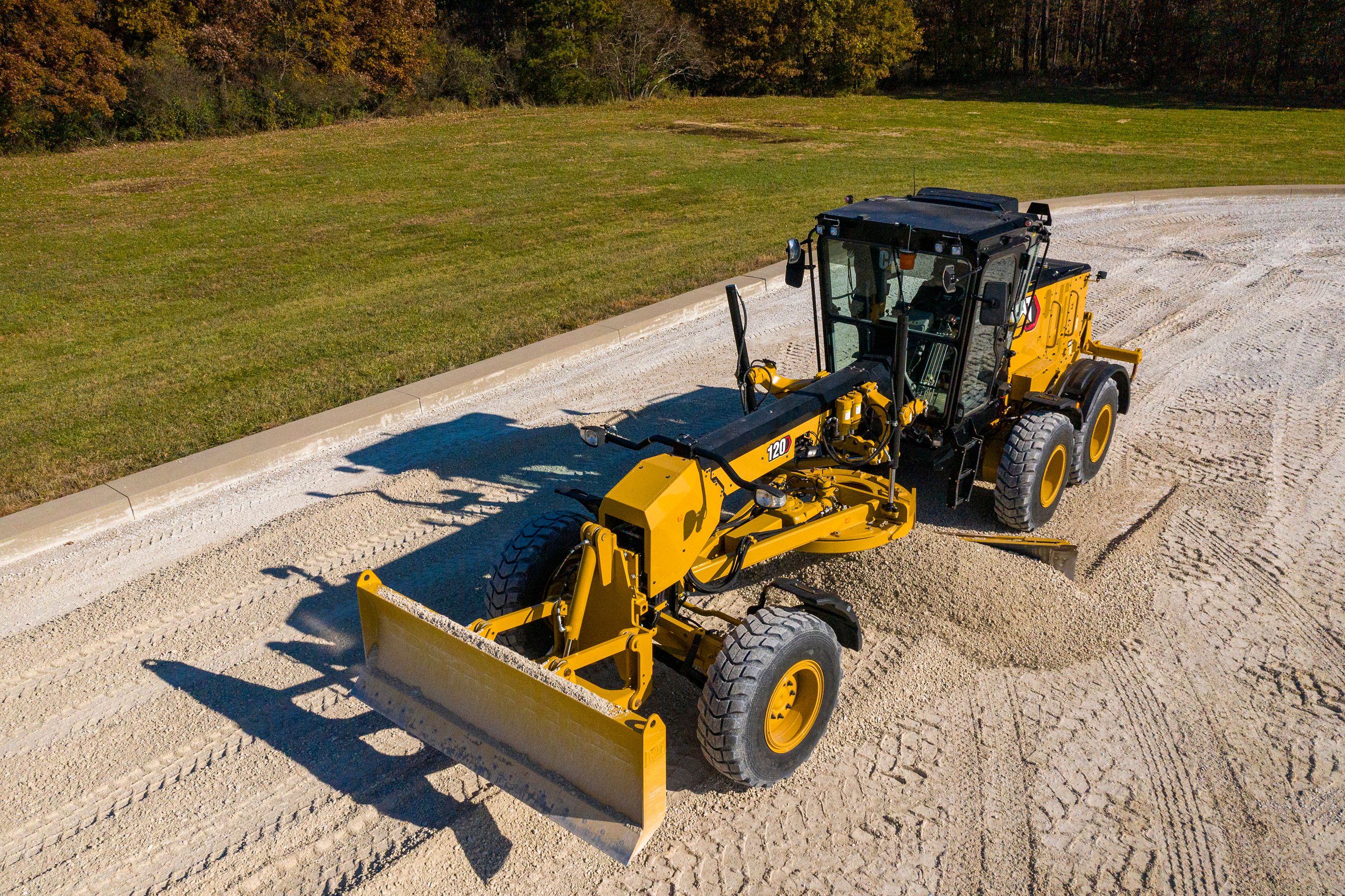

Sign In
Welcome! Sign In to personalize your Cat.com experience
If you already have an existing account with another Cat App, you can use the same account to sign in here
Register Now
One Account. All of Cat.
Your Caterpillar account is the single account you use to log in to select services and applications we offer. Shop for parts and machines online, manage your fleet, go mobile, and more.
Account Information
Site Settings
Security
Author: Small Business Expert | March 23, 2023 | Topic: Used Equipment

Your equipment's durability and reliability matter to you. You'll need to conduct machine maintenance if you want to keep your motor grader in the best shape for optimal performance.
To make it simple, we're sharing the best motor grader maintenance tips for making the most of your equipment and boosting your return on investment. Performing regular preventative maintenance tasks can extend the life and improve the functionality of your equipment. Learn more with this motor grader maintenance guide.
How to Maintain a Motor Grader
Before getting into the specific tasks you should complete for maintaining your equipment, there are some important ways to approach machinery upkeep. The following are considerations for how to maintain a motor grader to the best of your ability:
Know Your Equipment
One of the most important ways to maintain a motor grader is to understand its machinery well. All operators should have training and knowledge about their equipment. Manuals and handbooks give instructions for the best upkeep and operation.
Operators must know what to look for and where to look for to keep motor graders functioning properly and for longer. For example, they should know where to check for leaks. The sooner you identify areas that require extra attention, the sooner you can address the issue and reduce any need for downtime.
Reading the motor grader manual and inspecting your equipment will help you maintain your equipment and get the most out of each piece.
Stay On a Schedule
Creating a motor grader maintenance schedule is easy when using the specifications in your equipment manuals and handbooks. There are many instructions for how often you should perform certain tasks. There are suggestions for many maintenance practices, such as the following:
- How often to change air filters
- How frequently to lubricate grease points
- When to change the oil
Having a schedule for these tasks allows your team to find issues early. Schedules allow for consistency and better upkeep of motor graders. Let your team know about the maintenance schedule and give your employees specific instructions for sticking with that routine.
It can be especially helpful to keep the schedule posted for your team to reference and ensure all operators are on the same page.

Keep Records
Just as it is important to stick with a schedule, keeping records of every maintenance task your team performs will help you keep a closer eye on your equipment.
Even if they are super simple, detailed records leave less room for overlooking issues with your machine. Records with specific dates and repair information will help your team track recurring problems. Records also allow teams to spend less time figuring out what maintenance you've recently performed to prevent repeated tasks and confusion.
Keeping track of your maintenance also allows you to better monitor your equipment's overall performance. Records let you avoid problems that lead to downtime or more expensive issues.
Be Proactive
Being proactive is the best way to keep equipment in its optimal condition. Keeping on top of maintenance efforts for your motor grader will help you stay one step ahead of problems and allow you to protect your equipment before it needs expensive repairs.
If your motor grader is already in need of a repair, tending to this promptly will help you extend the life of your equipment and avoid the need for a replacement. Taking preventive measures will keep your motor grater functioning at its best and operating for longer.
10 Motor Grader Maintenance Tips
There are many ways to care for your equipment. The following are 10 tips for motor grader maintenance:
1. Complete Daily Pre- and Post-Operation Inspections
Operators should always complete a pre-operation inspection before starting the machinery. This is both for safety reasons and to ensure that the motor grader is ready to get to work. We are sharing more information about what you should look for during your daily equipment walk-around later on.
Before wrapping up for the day, operators should also complete a post-operation inspection. This will help your team identify motor grader areas that need cleaning or further inspection.
2. Regularly Check Engine Components
Again, routine inspections are incredibly valuable for the health of your equipment. You should be especially mindful when checking engine components.
Your engine is one of the most expensive parts of your machine. To take the best care of it, pay close attention to its components, including the following:
- Coolants
- Fluid levels
- Hydraulic system
- Air filters
Your motor grader's manual will note optimal timing for maintenance tasks regarding your engine.
3. Do These Things Before Starting the Machine
Before firing up your motor grader, there are some important things to do first, including:
- Survey the machine: Conduct a walk-around of your equipment and check for any defects or wear. Look for any leaks and check the underneath of the motor grader.
- Grease the machine: Keeping your grease points lubricated is a crucial part of motor grader upkeep.
- Check levels: Before starting the machine, check on fuel and oil levels. Give coolant levels a look and add more fluids if necessary.
- Test controls: You'll want to test each control at the beginning of every workday. Make sure to test out the steering and the accelerator before starting your equipment.
4. Sample Engine Oil Every 250 Hours
Performing an oil analysis is incredibly crucial for keeping your equipment running well. Oil is like the blood of your machinery. You should analyze your oil at least every month or every 250 hours for diesel engines. Keep a record of oil sampling and stay ahead of routine upkeep.
It is also important to look for any metal shavings or fluid leakage that should not be in your motor grader's oil.
5. Keep Lubricant on Grease Points
Keeping your grease points lubricated will allow your equipment to function at its best while reducing wear and tear. In addition to cleaning and servicing your seals, you will want to lubricate the following areas to ensure they are greased and ready for work:
- Front attachments
- Quick attach
- Moldboard
- Lift cylinders
Use your equipment's manual to find all pivot points that require lubrication. Greasing all of the moving parts on your motor grader is crucial because improper lubrication can lead to serious issues and even damage your machinery.
6. Monitor Clevis Points and Pins
Keeping a close eye on the clevis points and pins where the hydraulic cylinders attach to your motor grader can help you keep dirt and slop from speeding up wear.
The more dirt and debris that gets in these pins, the more damage it can do. As wear develops, your blade is less stable, and your grading will be less accurate.
7. Address Leaks Immediately
Checking leaks is a vital part of any routine motor grader maintenance. You can expect a small amount of leakage as the seals on your equipment age. However, you should promptly address leaks of more than just a couple of drops.
Check the circle drive and the blade linkage for leaks. Clean dirt and debris buildup that can lead to damaged seals. Pay attention to leaks from your transmission as well by regularly gauging fluid levels.
8. Keep Engine Openings Clean
Be sure to remove dirt and grime from the engine openings on your machine. This will help keep your engine running properly and reduce unnecessary wear.
Another helpful tip is to wipe away all buildup and grease before opening filler necks and dipsticks to avoid letting dirt in those openings.
9. Inspect Cooling System Regularly
Your cooling system is a very valuable part of your machine. It helps to prevent the following conditions:
- Freezing
- Corrosion
- Cavitation
- Rust
These things can be detrimental to your equipment, so keeping a close eye on this system will help you maintain your motor grader better. Check coolant levels regularly and add fluid if necessary to keep your equipment up and running.
10. Gauge Tire Pressure Often
It is beneficial for operators to check tires regularly. If a tire is damaged or deflated, this can create dangerous driving conditions and negatively impact the performance of your motor grader.
Make it a point to give tires a closer look and gauge their pressure often. Add air promptly to keep your machine ready for work.
Daily Walk-Around Motor Grader Inspection Checklist
There are some tasks that operators should perform every day as part of your motor grader walk-around inspection. Consider the following checklist:
- Circle drive: You will want to check out your machine's circle drive every day. Look for any leaks or indications of leakage. Identify any damage or loose components.
- Cutting edge: The sharper the cutting edge is on your motor grader, the better it will move through the soil. Ensure that it is sharp and does not have any signs of damage, as this can impact your equipment's performance.
- Blade linkage: Take a look at the blade linkage on your machine. Inspect for signs of excessive play or damage. Identify and address any loose or missing parts.
- Tires: Check your tires for safety and performance reasons. If any tire pressure is low, add air before getting started on work for the day.
- Hydraulic system: Your hydraulic system requires some extra attention. Check for leaks by both looking at the equipment and listening to it. Pay mind to loose connections and lines. You will also want to look at the hydraulic oil level.
- Engine oil: Check your machine's engine oil level. Add more oil if necessary. Check on the oil level for your equipment's power shift transmission and pay attention to any leaks.
- Fuel level: Check your fuel level. If it is low, consider adding fuel before getting started for the day.
- Coolant level: Peek at your coolant level in your machine's radiator. And while you are there, you might want to check on other components, like hoses and fan belts. Take a look at the radiator cap and clamps as well. Make sure every part is present and secure.
- Airflow system: Give your attention to the airflow system on your motor grader. Check the air restriction indicator as well as the air cleaner and its connections. Consider replacing the air filter if it is dirty. If your model has a dust cup, you'll want to empty it.
- Air tanks: Take a peek at your air tank and drain the condensation. If your fuel sight bowl has condensation in it, you'll want to drain that too.
- Belts: Checking your belts is incredibly important. Check both their condition and for tension problems. You wouldn't want your equipment to break down because of a simple part, like a fan belt.
- Battery: When performing your daily walk-around inspection, don't forget to check on your machine's battery. Make sure connections are tight and have not corroded. Check on the electrolyte level. You may need to add water if necessary.
- Electrical wire: Peek at electrical wiring and connection. Pay attention to insulation and be sure everything is clean and in place.
- Safety devices: Before starting your machine, ensure every safety device is functioning properly.
- Lights: Test your motor grader's lights and be sure they are working. Lights are an important feature for safety. Replace any broken bulbs promptly.

Cat® Maintenance and Extended Protection Plans for Your Motor Grader
Cat® motor grader maintenance is extremely important for keeping your equipment running properly. Because of this, various Cat dealers offer customer value agreements and extended protection plans to make maintenance simple. These plans vary between dealerships.
Cat Customer Value Agreements
A Cat Customer Value Agreement (CVA) is an ownership plan designed to help you keep your equipment in excellent condition. Get the most out of your motor grader with the following benefits:
- Advice from dealer
- Easy parts acquisition
- Flexible payment terms
- Flexible service options
With a CVA, you can have peace of mind knowing you have easy access to monitoring tools to help you stay on top of your equipment's health management. Explore these options with your local Cat dealer.
Extended Protection Plans
Investing in your equipment is a big deal for any owner. You want your motor grader to function properly when you need it. Tackle unexpected repairs with an extended protection plan.
Even the best-built machines eventually need repairs, which always seem to happen at the worst time — right in the middle of a big job, when cash is tight or just after the warranty expires. An Equipment Protection Plan (EPP) for a new or used machine provides coverage beyond the standard machine warranty for parts and labor and protects you from unplanned repair costs. Request more information from your local Cat dealer.
Check Out Used Motor Graders Online With Cat Used
With these tips for maintaining motor graders, you will be able to take better care of your equipment and elongate its life. Our motor grader maintenance checklist makes it easy to keep an eye on the most important parts of your machine.
If you're looking for a motor grader, find a Cat dealer near you or explore the inventory on Cat Used today!



